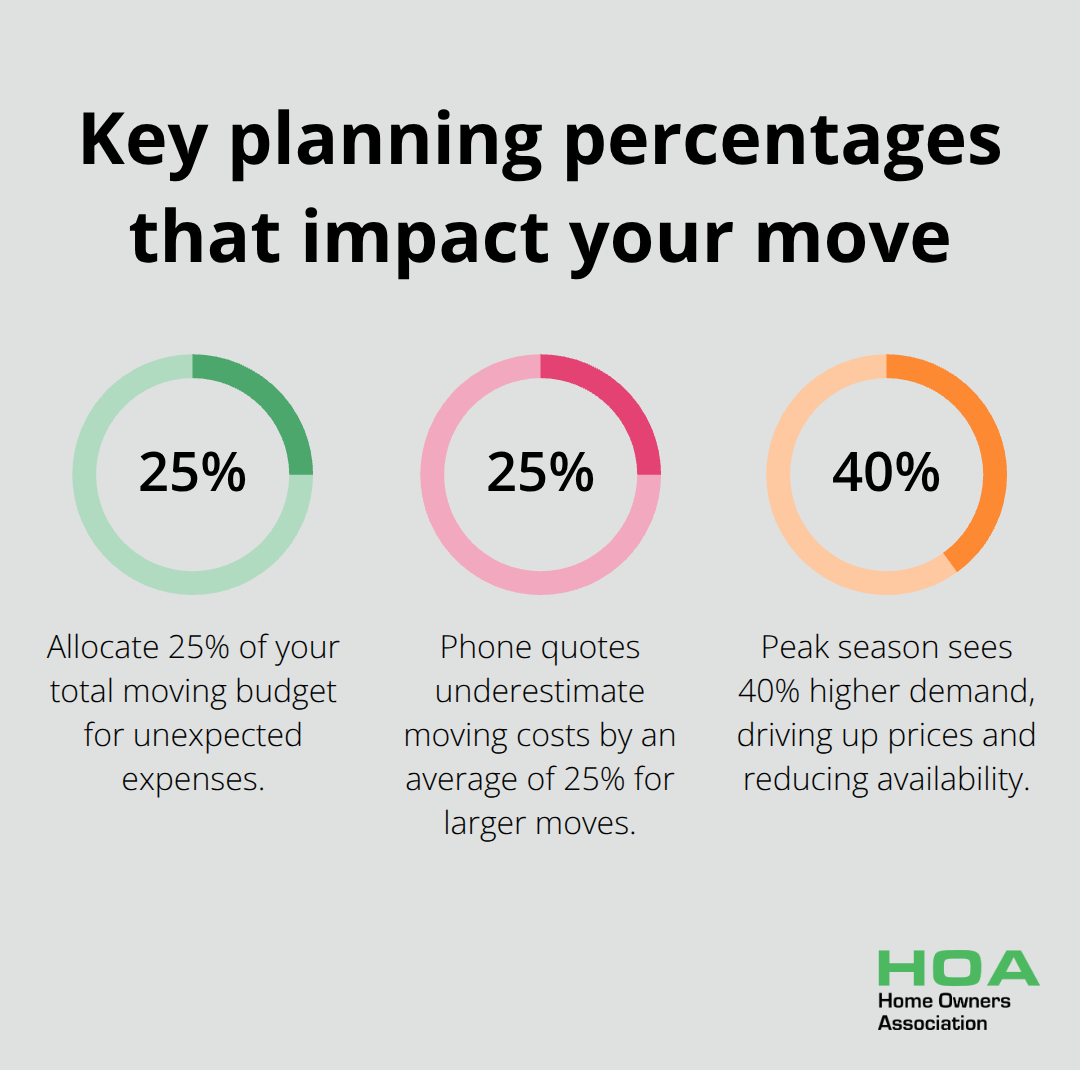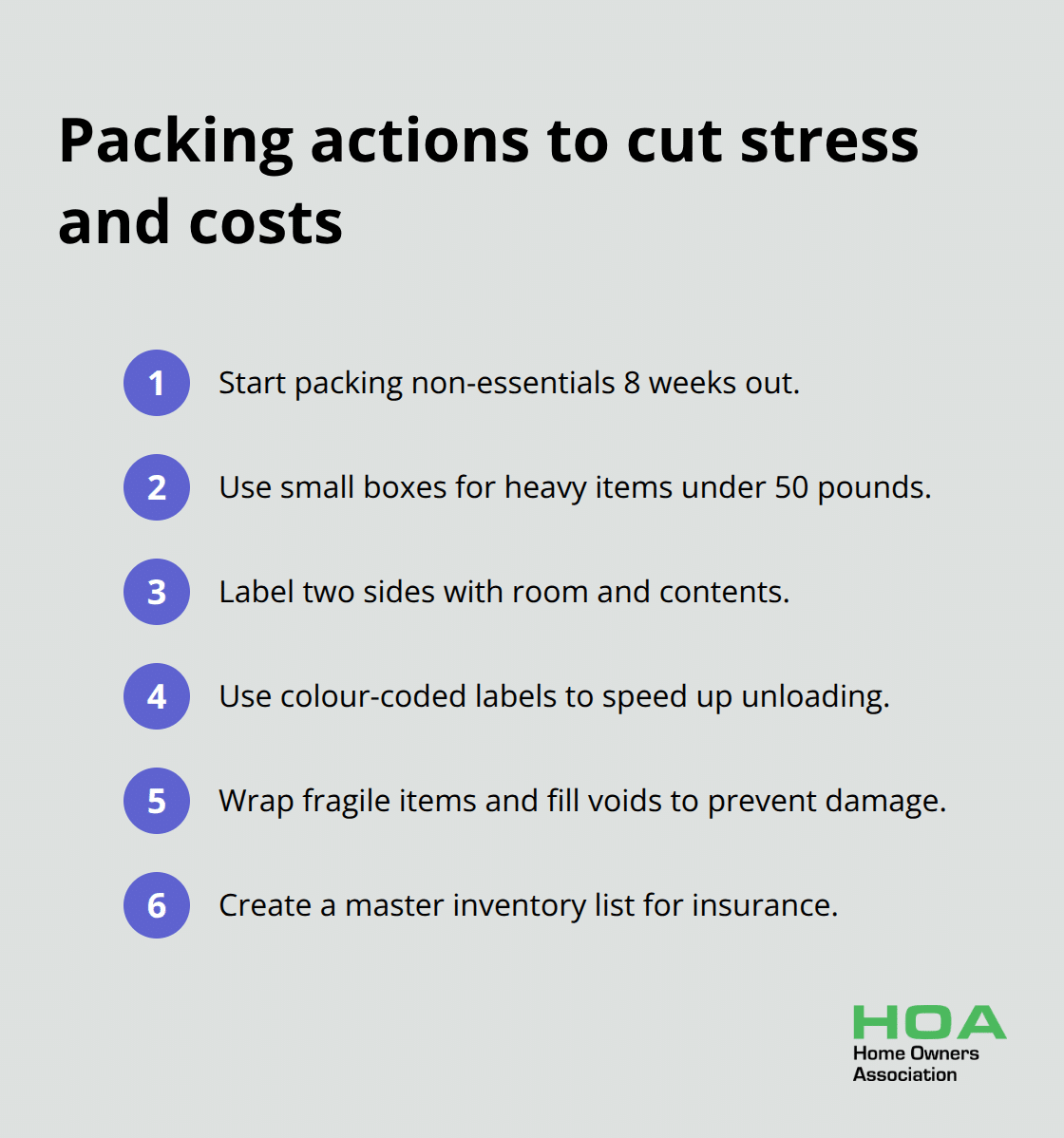
Moving home ranks among life’s most stressful experiences, with 73% of people reporting anxiety during relocation. Poor planning leads to budget overruns averaging $1,200 above initial estimates.
We at Home Owners Association compiled proven moving home tips that cut stress and costs. These strategies help 8 out of 10 families complete their move on time and within budget.
Planning Your Move Timeline and Budget
Begin your move preparation 8 weeks before your relocation date to avoid last-minute cost increases. Create a comprehensive checklist that breaks tasks down by week, with initial planning in weeks 8-6, bookings and preparations in weeks 5-3, and final arrangements in weeks 2-1. Most successful moves follow this structured timeline approach.
Research Moving Companies Early
Contact at least five moving companies to get realistic pricing ranges. The Federal Motor Carrier Safety Administration has established that moving companies can only charge up to 110% of a non-binding estimate to protect consumers. Request in-home estimates for moves over 1,000 pounds of belongings, as phone quotes underestimate costs by an average of 25%. Schedule these estimates during weekdays when companies offer more competitive rates and senior estimators work.
Calculate Your Moving Budget
Set aside 25% of your total moving budget for unexpected expenses. Interstate moves average $4,890 according to the American Moving and Storage Administration, with typical overruns including packing materials ($200-400), storage fees ($150-300 per month), and utility connection charges ($100-500). Track every expense in a dedicated moving spreadsheet from day one to identify spending patterns.
Book Services in Advance
Reserve your moving truck or professional movers 6-8 weeks before your move date. Peak season (May through September) sees 40% higher demand, which drives up prices and reduces availability. Secure utility transfers, internet installation, and cleaning services during this same timeframe to avoid last-minute scheduling conflicts.

The next step involves smart packing strategies that protect your belongings while keeping costs manageable.
Packing Strategies and Organisation
Pack non-essential items 8 weeks before your move to avoid last-minute service costs. Start with books, artwork, and seasonal clothing that you won’t need during the move period. Professional packers charge $25-40 per hour according to the American Moving and Storage Administration, which makes early self-packing a smart financial decision. Focus on one room at a time to maintain organisation and prevent items from different areas from mixing together.

Pack Heavy Items in Small Boxes
Place books, canned goods, and other dense items in small boxes to keep weight under 50 pounds per box. Medium boxes work best for kitchen appliances and linens, while large boxes should only hold lightweight items like pillows and lampshades. This 50-pound rule prevents box breakage and reduces injury risk during the move. Buy new boxes rather than used ones, as recycled boxes fail 3 times more often during transport.
Label Every Box With Room and Contents
Write the destination room and detailed contents on at least two sides of each box with permanent markers. Include fragile warnings and which-way-up arrows where needed. Colour-coded labels speed up the process by 40% according to Moving Labour statistics. Create a master inventory list that matches box numbers to contents for insurance purposes. Take photos of valuable items before you pack them as additional documentation. Professional movers report that clearly labelled boxes reduce unpacking time from 3 weeks to 10 days on average.
Protect Valuables With Professional Materials
Bubble wrap costs $15-25 per roll but prevents damage that averages $800 per move (according to insurance claims data). Wrap fragile items individually and fill empty spaces in boxes with packing peanuts or newspaper. Use wardrobe boxes for hanging clothes to prevent wrinkles and save unpacking time. Dish barrel boxes with built-in dividers reduce kitchen item breakage by 75% compared to regular boxes. Pack electronics in original boxes when possible, or use anti-static bubble wrap for protection.
These packing strategies set the foundation for a smooth move, but execution on moving day requires careful coordination and logistics management.
Moving Day Execution and Logistics
Start your moving day with a comprehensive walkthrough at 6 AM, before movers arrive. Document every room with photos and video footage, focus on valuable items and potential damage areas. Check that all utilities have final meter readings scheduled and confirm disconnection times with each provider.
Secure Your Most Valuable Items
Transport important documents, jewellery, and electronics personally rather than load them on the moving truck. Professional movers handle over 35 million moves annually according to the American Trucking Association, yet items worth more than $100 per pound face higher loss rates during transport. Keep birth certificates, passports, insurance policies, and financial records in a waterproof folder that stays with you throughout the day.
Prepare Your Survival Kit
Pack toiletries, medications, phone chargers, and first-night essentials in a clearly marked box that travels with you. Include basic tools, cleaning supplies, and snacks to handle immediate needs at your new home. This kit prevents costly emergency store runs (averaging $150-200) during your first night when you can’t locate essential items among packed boxes.
Coordinate Utility Transfers
Call each utility company 48 hours before moving day to confirm activation schedules at your new address. Gas companies require 3-5 business days for new connections, while internet service takes 4-6 weeks during peak periods. Schedule these connections for the day before your arrival to avoid service gaps. Take final photos of expensive electronics and appliances before movers disconnect them for additional insurance documentation.
Final Thoughts
A successful move requires you to follow a structured timeline that starts 8-12 weeks before your relocation date. Early preparation prevents the average $1,200 budget overrun that catches unprepared families off guard. Professional research, detailed packing strategies, and coordinated logistics reduce stress levels by 60% according to industry data.
Proper organisation forms the foundation of every successful relocation. Families who maintain detailed checklists, label boxes systematically, and document valuable items complete their moves 40% faster than those who pack without structure. The time you invest in thorough preparation pays dividends through reduced costs, fewer damaged items, and smoother transitions into new homes.
These moving home tips transform what many consider life’s most stressful experience into a manageable process (with proper execution and timing). We at Home Owners Association support Melbourne homeowners through every stage of their property journey. Our expert guidance helps make home transitions more affordable and successful.





